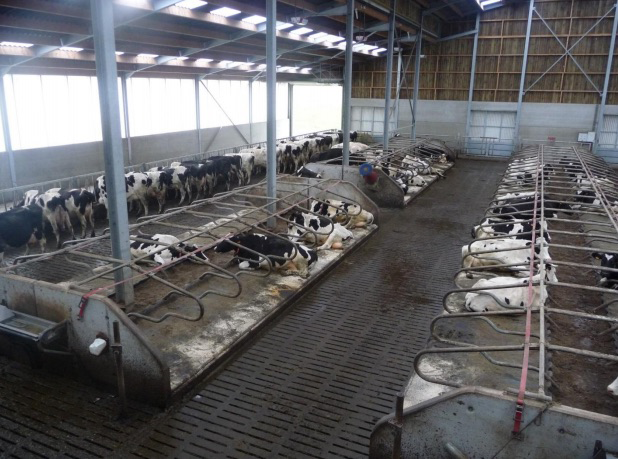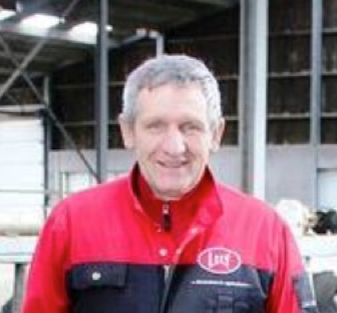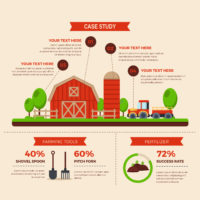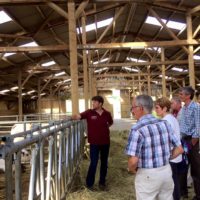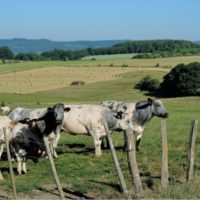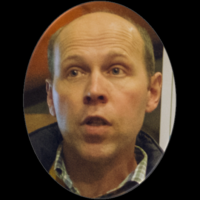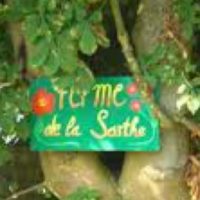Combining grazing and automatic milking
Jean-Claude Willem
 Combining grazing and automatic milking (.pdf)
Combining grazing and automatic milking (.pdf)
 Associer robots et pâturage (.pdf)
Associer robots et pâturage (.pdf)
Description
Jean-Claude Willem has sought to automate as much as possible all burdensome jobs in his farm: slurry cleaning and scraping, feeding the herd (Automatic dispenser of milk for calves, concentrate for lacting cows, for calves and for dry cows, setting and monitoring by collar) and milking. To encourage the animals to go out and graze, the strip grazing (rotating on 1 day) has proved an excellent technique. The monitoring ensured by robots also offers precise and remote control of the health and production parameters.
The farm was monitored by the “Autograssmilk” project.
Thanks to those different robots, the working conditions have been improved and the management of the farm is more efficient, both for the productivity of the grassland and the milk collected. Animal health is also better controlled.
The rotating grazing technique was inspired by a study trip in Ireland with Dairyman project. It has been calibrated thanks to a plate meter.
All repetitive tasks are automated
- Milking robots
- Duckboard cleaning
- Automatic feed pusher
- A.M.D. for calves
- A.C.D for cows, for calves up to 9 months et for dry cows
The use of milking robots and automatic feed dispenser are common in breeding in barn. Associated with rotational grazing, it can also be
considered for grazing.
Farm description
Environment
The poor soils (schist-loam) and especially the harsh climate (Haute Ardenne, altitude of 500 m) are unfavourable for crops, but favourable for grasslands. The farm is located in a typical dairy farming area.
Grassland management
Grasslands, mostly permanent, are almost all (96%) both grazed and mowed (3-4 times a year). The duration of permanent meadows is longer than 10 years. The
rotational stocking on a day only (strip grazing with front and back wires) is preferred, it lasts about 7 months per year. Grass is ensiled or stored in haylage bales for winter, but hay is harvested as weather permits.
Structure
- Annual Work Unit: 2
- Agricultural Area : 154 ha UAA
- The farm is managed by the owner and his son
- It has 154 ha of UAA, only with fodder crops and mostly in permanent (80 ha) and temporary (50 ha) grasslands. Small area provides cereals (20 ha) and 4 ha of semi-sugar beet, i.e. 1.1 LU / ha UAA (1.3 / ha for grassland)
- In 2015, the daily cost of feed varied between € 3.15 (September)to € 5 (winter) per cow, or € 0.12 to € 0.187 / kg of milk
- The cattle is Holstein: 160 lactating cows, 200 heifers and calves, and 10 males.
Animal performance
- The average milk production is: 9,080 kg of milk / cow / year with 660 Kg of useful matter (official milk control).
Why it is working
Automation is allowed by new and well-adapted buildings. The rotating pastures request meadows accessible from the barn. The introduction of
automated systems has completely changed the way of working and has called for a sometimes difficult adaptation period.The management of the rotational grazing relies on the herbometer, which has become useless only after three years.
Additional information
| Farming system | conventional farming |
|---|---|
| Domains of innovation | animal feeding management, grazing management system, machinery, tools |
| Main types of animal | dairy cattle |
| Country | Belgium |
| Product type | Farmer portrait |
| Language | English, French |
